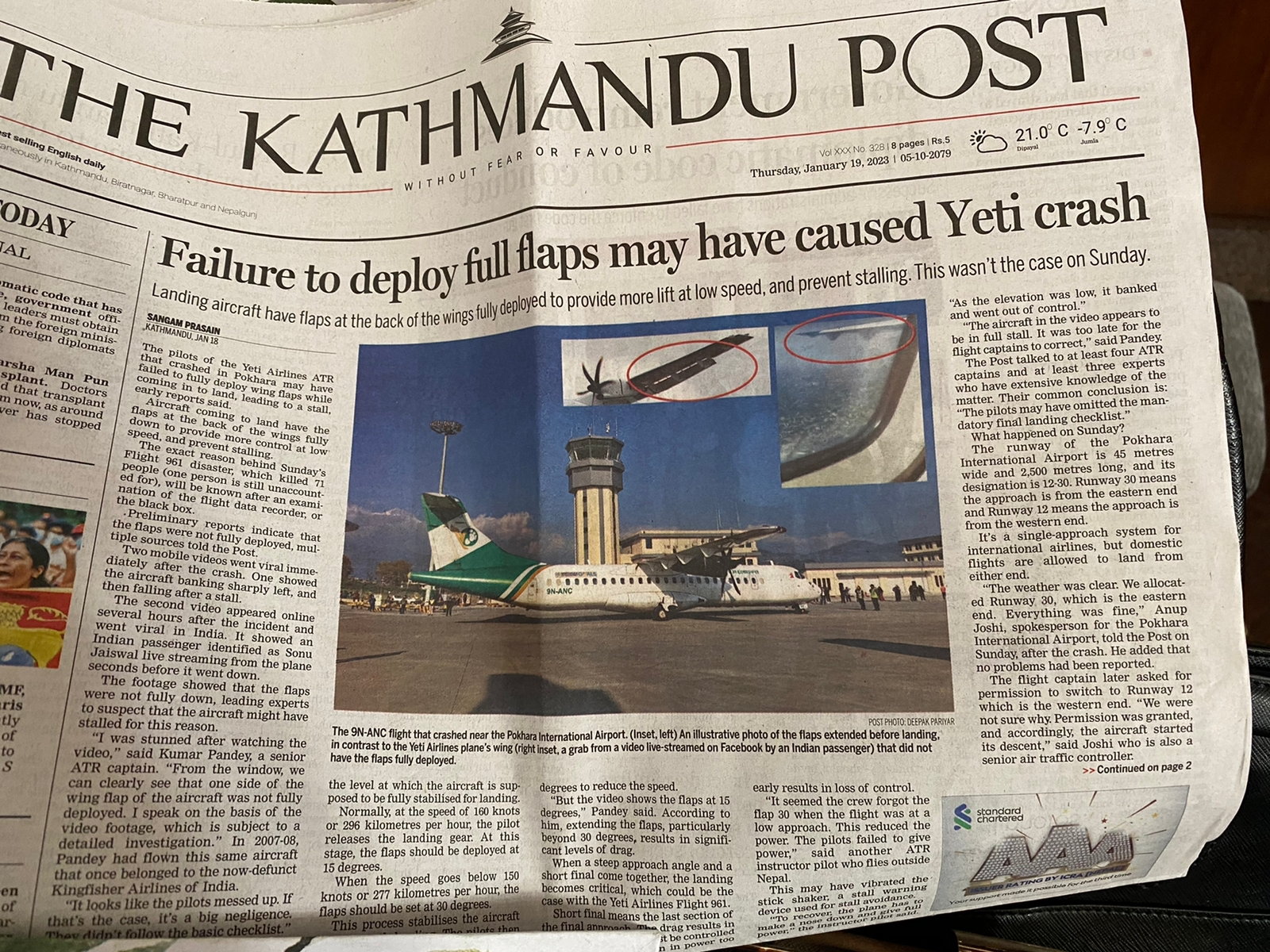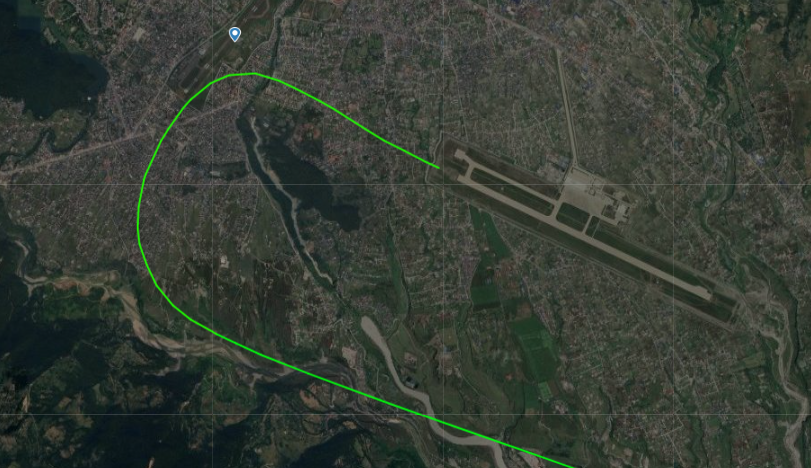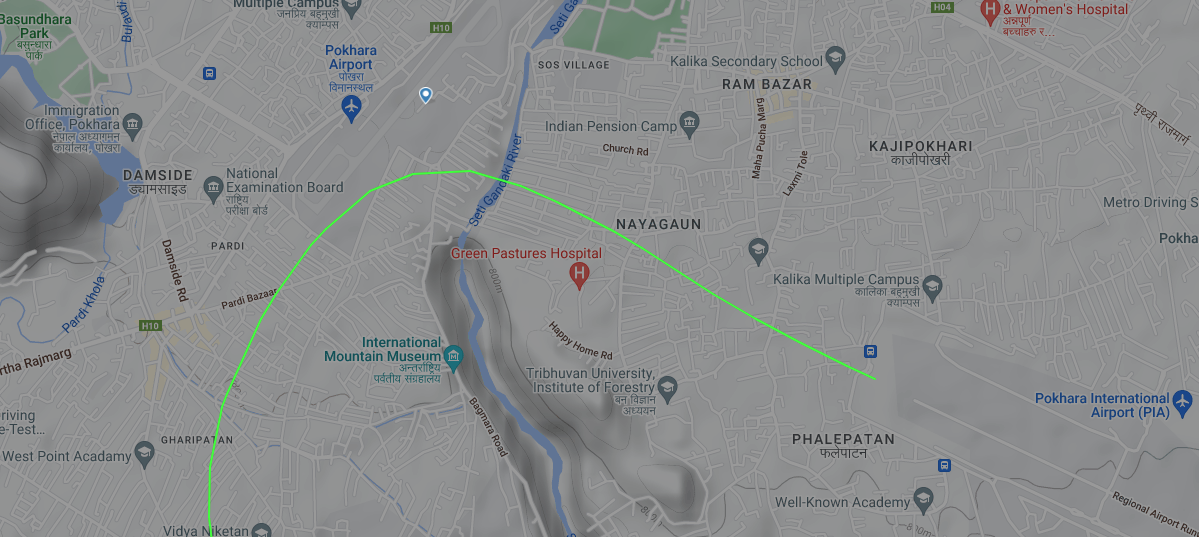Nepal Plane Crash
Thanks BO0m we don't of course know the wind, which would also effect groundspeed. Just a wild thought, but is it possible that the pitch angle might be the start of an attempted go-around?
If I understood correctly the procedure would be to fly Flaps 15 at around 150 knots downwind, then turn base reducing speed and selecting Flaps 30 to aim for a Vref 107 + 5(min). There is no auto thrust so power would set by the pilot flying, probably near idle as they reduced speed. If they got distracted managing the final turn and did not increase power, speed would decay pretty rapidly. Also if you were below 500 feet the stuck pusher would be inhibited. Is that a reasonable summary?
Go-arounds are one of the worst flown (standard) manoeuvres. It seems a stretch that they would not firewall the thrust levers, but I have heard of weird reactions in similar situations.
If I understood correctly the procedure would be to fly Flaps 15 at around 150 knots downwind, then turn base reducing speed and selecting Flaps 30 to aim for a Vref 107 + 5(min). There is no auto thrust so power would set by the pilot flying, probably near idle as they reduced speed. If they got distracted managing the final turn and did not increase power, speed would decay pretty rapidly. Also if you were below 500 feet the stuck pusher would be inhibited. Is that a reasonable summary?
Go-arounds are one of the worst flown (standard) manoeuvres. It seems a stretch that they would not firewall the thrust levers, but I have heard of weird reactions in similar situations.
The later/last still of the flaps from the passenger video, to my eye, clearly showed them deployed at a greater angle. So the photo in this article doesn't necessarily seem relevant. Possibly, deployment was delayed, but I wouldn't know what the appropriate timing for that approach is.
Thanks BO0m we don't of course know the wind, which would also effect groundspeed. Just a wild thought, but is it possible that the pitch angle might be the start of an attempted go-around?
If I understood correctly the procedure would be to fly Flaps 15 at around 150 knots downwind, then turn base reducing speed and selecting Flaps 30 to aim for a Vref 107 + 5(min). There is no auto thrust so power would ...
If I understood correctly the procedure would be to fly Flaps 15 at around 150 knots downwind, then turn base reducing speed and selecting Flaps 30 to aim for a Vref 107 + 5(min). There is no auto thrust so power would ...
The ordinary weather website I found had surface wind 6 mph SSE at 9am, 2 mph S at midday. Crash is just before 11 am. Of course we don't know what sort of wind gradient there would be.
Someone said the videos are irrelevant. Perhaps not completely. The one from the bloke on the ground can be used to deduce a reasonable estimate heading of the aircraft, ahead of better info from the data recorder. The one from the helicopter flying around the scene afterwards confirms a southerly wind from low down to the height the helicopter is at.
Increasing pitch angle is not the first stage of a go around procedure.
First you increase power as you are already low and slow
Then you apply some elevator pressure to slow and stop the descent
once stabilised you can think about climbing and starting to retract flaps at appropriate speed and retracting undercarriage
climb to go around altitude, enter the pattern, or whatever else ATC tells you to do.
In a nutshell power, pitch, flaps, gear.
First you increase power as you are already low and slow
Then you apply some elevator pressure to slow and stop the descent
once stabilised you can think about climbing and starting to retract flaps at appropriate speed and retracting undercarriage
climb to go around altitude, enter the pattern, or whatever else ATC tells you to do.
In a nutshell power, pitch, flaps, gear.
Whatever they were doing it seems likely that managing the power was not getting the attention it required. In the airliners I have flown you announce your intention by calling go-around then press TOGA and push the thrust levers forward, check the mode annunciation, select GA flap and with positive rate of climb gear up. As far as pitch goes you follow the flight director. Merely slowing the rate of descent is likely to bust the minimum on a sim check, so I would suggest the muscle memory for most airline pilots is not quite as described above. The Emirates 777 Dubai crash is a good example of what happens when for some reason you don’t have go-around power.
Well the Emirates crash was pilot error, no fault of the plane.
The flight crew did not effectively scan and monitor the primary flight instrumentation parameters during the landing and the attempted go-around. The flight crew were unaware that the autothrottle (A/T) had not responded to move the engine thrust levers to the takeoff/go-around switch (TO/GA) position after the commander pushed the TO/GA switch at the initiation of the FCOM ̶ go-around and missed approach procedure.
The flight crew did not effectively scan and monitor the primary flight instrumentation parameters during the landing and the attempted go-around. The flight crew were unaware that the autothrottle (A/T) had not responded to move the engine thrust levers to the takeoff/go-around switch (TO/GA) position after the commander pushed the TO/GA switch at the initiation of the FCOM ̶ go-around and missed approach procedure.
The later/last still of the flaps from the passenger video, to my eye, clearly showed them deployed at a greater angle. So the photo in this article doesn't necessarily seem relevant. Possibly, deployment was delayed, but I wouldn't know what the appropriate timing for that approach is.
My experience of observing the flap setting markings when seated by appropriate window is that straight upon flap 30 the aircraft is typically put into a distinct nose down attitude until the flare. Compared to other aircraft it’s a relatively “diving” approach with engines relatively quiet. Other turboprops I travel on board tend to have a flatter final approach on “higher revs”, eg Saab 340.
Join Date: May 2008
Location: Euroland
Age: 53
Posts: 152
Likes: 0
Received 0 Likes
on
0 Posts
You do not stall because you delay flap extension, you could stall by flying an inappropriate speed for the flaps you actually have and thereby exceeding critical angle of attack while disregarding all preceding warnings (buffet, airspeed low warning, stall warning, stick shaker...). You can safely land without using flaps, provided the runway is long enough to allow for the increasing landing distance. If you stall the aircraft it means you ****** it up big time.
Increasing pitch angle is not the first stage of a go around procedure.
First you increase power as you are already low and slow
Then you apply some elevator pressure to slow and stop the descent
once stabilised you can think about climbing and starting to retract flaps at appropriate speed and retracting undercarriage
climb to go around altitude, enter the pattern, or whatever else ATC tells you to do.
In a nutshell power, pitch, flaps, gear.
First you increase power as you are already low and slow
Then you apply some elevator pressure to slow and stop the descent
once stabilised you can think about climbing and starting to retract flaps at appropriate speed and retracting undercarriage
climb to go around altitude, enter the pattern, or whatever else ATC tells you to do.
In a nutshell power, pitch, flaps, gear.
Join Date: Mar 2018
Location: Kathmandu
Posts: 46
Likes: 0
Received 0 Likes
on
0 Posts
We have a FR24 for a flight on runway 12 on the new airport that goes over the old airport .
https://www.flightradar24.com/data/a...n-amz#2ed30fdb
The difference is that this is coming from the left while the crash flight is coming from the right . Both would mean getting over the old airport . https://www.google.com/maps/d/edit?m...TE&usp=sharing
https://www.flightradar24.com/data/a...n-amz#2ed30fdb
The difference is that this is coming from the left while the crash flight is coming from the right . Both would mean getting over the old airport . https://www.google.com/maps/d/edit?m...TE&usp=sharing
de minimus non curat lex
You do not stall because you delay flap extension, you could stall by flying an inappropriate speed for the flaps you actually have and thereby exceeding critical angle of attack while disregarding all preceding warnings (buffet, airspeed low warning, stall warning, stick shaker...). You can safely land without using flaps, provided the runway is long enough to allow for the increasing landing distance. If you stall the aircraft it means you ****** it up big time.
Stalled in the turn with insufficient height to recover.
Join Date: Mar 2018
Location: Kathmandu
Posts: 46
Likes: 0
Received 0 Likes
on
0 Posts
As per the videographer , the plane should have already turned by the time video starts , ie: the plane should not have been coming towards him and should be flying parallel above him . Based to previous flights he saw.
Will a stall or stall recovery take this kind of path?
Will a stall or stall recovery take this kind of path?
As mentioned by GAWLC - the offset approach to Hong Kong Kai Tak - I hope at least one video of that still exists in the public domain and is viewable for free.
Sharp turns on finals - pah! First, descend directly towards a hill; then, throw in the sharp turn for additional excitement.
Sharp turns on finals - pah! First, descend directly towards a hill; then, throw in the sharp turn for additional excitement.
Join Date: Jan 2023
Location: NC
Posts: 59
Likes: 0
Received 0 Likes
on
0 Posts
Flap extension is the most problematic time for a tail plane icing event. The conditions suggest at least the last part of the flight was in VMC, what conditions existed before that BO0M has commented on. Not that long ago, right over the top of Kunming, in winter doing one of their interminable arrivals, we descended through some some interesting AS, the kind you like to see in the ski season, but not in a plane. NAI went on before entry, and we had a camera running. We picked up 3/4" of ice in 5 seconds. In 28,000 hours of driving, have never seen ice pick up that fast. Point is, there are conditions that may seem benign, and result in severe ice accretion. If that happened, it would be discernible in the FDR data as a rapid change in the drag polar, and where there may be GPS data, then the change in CL can be quickly determined. Did that happen? Hard to say (easy to drink... Johnny Walker) The data will rule it in or out.
On the SEV ICE memo, there are a lot of natural cues that a plane is carrying ice, if the crew are interested in the proceedings, I am not sure that i have ever had any alert system that has not given erroneous data at some point... Would hope that peeps driving "plains" are never basing their continued happiness and well being on any single source being good.
As a profession we seem to "double cross the bridge" on stalls and our responses to that. Seems a tad untidy, and is hardly well received by the self loaders that pay our bills. A stall is not something that we should be fearful of, even in a T tail, like the B727, Cl600 or a Lear, or an ATR, stick pusher or not. Even a Trident getting parked vertically at Staines. Yes, if you abuse the plane for long enough it will get bitey, and the recovery from that, while quite possible needs a chunk of airspace between the pointy bit and the hard lumpy bits. The F-102 is about the most notable exception to that statement, it goes from tidy to untidy really really quickly. Still has to be abused, but, golly. The Staines, BAC 1-11, B-727 accidents wee all held in the condition by the crews for longer than the plane was prepared to put up with. Don't go out and stall the planes for the heck of it, the loads imposed on the tail alone are reason enough to avoid that, but the aircraft will stall, and will still respond correctly to controls for a period of time, relaxing back pressure will break a stall, up until the point that the stall has been abused so far that the bark turns to bites. The thrust line of the ATR should provide a nose down pitching moment on application, however, as that also blows the inner wing and flaps that can become a skosh non linear. The blowing effect assists in attaching flow over the flaps at larger angles which increases lift but also increases the Cm, the downwash increase induces flow at the tail that tends to increase the nose up moment from the tail, and that can become a bit of an issue, what controls is dependent on the tail volume, arm and the geometry of the stab relative to the engines...
FDR
On the SEV ICE memo, there are a lot of natural cues that a plane is carrying ice, if the crew are interested in the proceedings, I am not sure that i have ever had any alert system that has not given erroneous data at some point... Would hope that peeps driving "plains" are never basing their continued happiness and well being on any single source being good.
As a profession we seem to "double cross the bridge" on stalls and our responses to that. Seems a tad untidy, and is hardly well received by the self loaders that pay our bills. A stall is not something that we should be fearful of, even in a T tail, like the B727, Cl600 or a Lear, or an ATR, stick pusher or not. Even a Trident getting parked vertically at Staines. Yes, if you abuse the plane for long enough it will get bitey, and the recovery from that, while quite possible needs a chunk of airspace between the pointy bit and the hard lumpy bits. The F-102 is about the most notable exception to that statement, it goes from tidy to untidy really really quickly. Still has to be abused, but, golly. The Staines, BAC 1-11, B-727 accidents wee all held in the condition by the crews for longer than the plane was prepared to put up with. Don't go out and stall the planes for the heck of it, the loads imposed on the tail alone are reason enough to avoid that, but the aircraft will stall, and will still respond correctly to controls for a period of time, relaxing back pressure will break a stall, up until the point that the stall has been abused so far that the bark turns to bites. The thrust line of the ATR should provide a nose down pitching moment on application, however, as that also blows the inner wing and flaps that can become a skosh non linear. The blowing effect assists in attaching flow over the flaps at larger angles which increases lift but also increases the Cm, the downwash increase induces flow at the tail that tends to increase the nose up moment from the tail, and that can become a bit of an issue, what controls is dependent on the tail volume, arm and the geometry of the stab relative to the engines...
FDR
As per the videographer , the plane should have already turned by the time video starts , ie: the plane should not have been coming towards him and should be flying parallel above him . Based to previous flights he saw.
Will a stall or stall recovery take this kind of path?
Will a stall or stall recovery take this kind of path?
It could be that he means the turn from that base leg to final is overshot or late with respect to the base leg (i.e. crossing the extended centreline), compared to others, or he might mean that others are already established on approach from a final turn a bit further out.
I'm not sure what help there is in the close ups of tracks of right hand circuits on other flights









